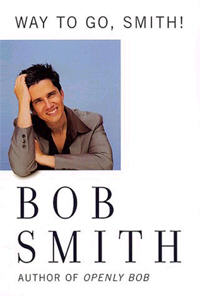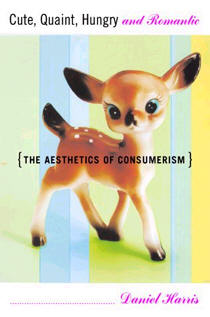 |


|
|
The Aesthetics of Consumerism Way to Go, Smith! Cute, Quaint, Hungry and Romantic: The Aesthetics of Consumerism by Daniel Harris; Basic Books; 270 pages; $24.00.
Some critics attacked Harris's praise for the days of camp, drag and Broadway show tunes as nostalgia for the closet, and some religious conservative used Harris's screed to bolster their antigay argument. (Harris hotly denied such homophobic implications.) In his latest collection of essays, Cute, Quaint, Hungry, and Romantic, Harris aims his critic's pen at "the aesthetics of consumerism", a largely untouched topic. "We are trained to look for art in only one location, on the walls of museums and galleries, whereas art is--and always has been-- entirely indiscriminate in its choice of venue, appearing on ketchup bottles, subway passes, digital alarm clocks, placemats, heating pads, and thermoses. . . . This psychic voyage into the aesthetic unconsciousness places the refuse of consumerism under a microscope and concentrates on minutiae, on the uses of the useless, the significance of the insignificant." Each chapter in Harris's book "defines one broad principle that governs the appearance of popular culture", whether it be "Cuteness", "Quaintness" or "Glamorousness". "Jeremiads against consumerism . . . and generally flawed," admits Harris, which of course didn't stop him from launching a 270 page jeremiad against consumerism. Harris is wise enough not to blame kitsch on godless capitalism, admitting that "If there is kitsch in our daily lives, it is because there is kitsch in our minds." Kewpie dolls and portraits of Elvis Presley on Velcro obviously fill a need in people's lives.
Cute, Quaint, Hungry and Romantic goes on (and on and on) about how the artifacts of popular culture misguide us. For example, in the chapter on "Cuteness", we learn that cuteness is not synonymous with beauty but its opposite: that it "aestheticizes unhappiness, helplessness, and deformity." The teddy bear, the epitome of cute, evolved from the slim specimens of Teddy Roosevelt's time to today's "moon-faced dough boy whose corpulence invites caressing." Harris goes on to note that "all stuffed animals, from marsupials to pachyderms, are covered in fur", no doubt to increase their CQ (cute quotient). Now I happen to collect stuffed animals, and I see nothing wrong with them being husky or furry--qualities that I also appreciate in men. Just as cuteness subverts real beauty, quaintness is "that most ahistorical of aesthetics," which "reproduces the past selectively, editing out its discomfort, inconvenience, misery, stench, and filth and concentrating instead on its carnal pleasures, its 'warm and homey feelings.' "Renaissance fairs, after all, do not exist to remind us about the high rate of infant mortality in the Sixteenth Century, or that one third of Europe's population died of the bubonic plague. But Harris goes further, arguing that our fad for antiques and "collectibles" "reveals that we hold our forbears and their inventions in contempt and that history has receded altogether from our lives, leaving behind the wreckage of archaic appliances, which we have salvaged from the shores of time and converted into ornaments for our kitchens and living rooms." "As a cultural critic and not a visionary or prophet, I have always felt that it is sufficient for me to destroy--to slash, to burn--and have never felt any desire to formulate utopian solutions". Rants are fine, provided they are clever and make us think like the ravings by a George Bernard Shaw or a Dennis Miller. Unfortunately, Harris's 270 page ramble about the "aesthetics of consumerism" turns the reader off to such an extent that he or she won't care that telephones no longer "ring". Readers who expect an "encyclopedia of low-brow aesthetics" (to quote the dust jacket blurb) will find instead a loosely-joined collection of attacks against whatever pops out of the author's mind. To put it plainly, Cute, Quaint, Hungry and Romantic is none of the above. It is only dull. Way to Go, Smith! by Bob Smith; Rob Weisbach; 285 pages; $24.00.
 Bob Smith is a stand-up comic and writer whose first book, Openly Bob (1997), won
a well-deserved Lambda Literary Award. He is the first openly gay comedian
to appear on The Tonight Show and to star in his own HBO special. Though
best-known as a gay comic, Smith's "identity as a comedian is stronger than
my sexual orientation--I've cracked a joke in bed but I've never had the
desire to have sex on a stage." Smith has also written for the MTV Video
Awards and other TV shows.
Bob Smith is a stand-up comic and writer whose first book, Openly Bob (1997), won
a well-deserved Lambda Literary Award. He is the first openly gay comedian
to appear on The Tonight Show and to star in his own HBO special. Though
best-known as a gay comic, Smith's "identity as a comedian is stronger than
my sexual orientation--I've cracked a joke in bed but I've never had the
desire to have sex on a stage." Smith has also written for the MTV Video
Awards and other TV shows.
A good writer has the talent to make his ordinary life seem extraordinary to his readers, and "openly Bob" is a very good writer. In "Wolf Whistling in the Dark", the essay that opens Way To Go, Smith!, Smith writes wistfully but philosophically about the end of his ten-year relationship with Tom: "Over the course of ten years we had made the natural transition that every couple makes from fucking like bunnies to fucking like Easter bunnies. Every time we had sex, it felt like a holiday. But during our last year together there were no holidays." "I loved Tom and I loved my work, but it became clear to me and to Tom that I was living my life with him the way a selfish boy divvies up a single stick of gum. I was willing to share, but I wanted to keep the biggest piece for myself. At some point I needed to grow up and learn to give the bigger piece to someone else," he admits. In Way to Go, Smith!, the author looks back with humor at the people and events that shaped his life. There's Mr. McGaffin, Bob's fourth-grade teacher, who kept his class-room decorated year 'round: "I didn't know then that Mr. McGaffin was gay but I did recognize that he was different. He stood out because he was the only man in Buffalo I knew who read poetry, wasn't fat after the age of thirty, and never talked about sports." "Mr. McGaffin was also different from other men because he was frequently met after school, by his fair-haired 'friend' Jeffrey and their German shepherd, Lucy," he adds. Fifth-grade biology was equally memorable, if only because young Mr. Smith fainted during a slide presentation: "The last image I remember before passing out was an explanation of peristalsis featuring X-ray footage of an esophagus in the act of swallowing. . . . I hit the floor as if I was trying to tackle my own shadow and my smooth move was cheered on by Mark Deffler. 'Way to go, Smith!' he called." [hence the title of this book] As for Smith's high school years, a dreadful time for any gay teenager, our hero has a novel way of remembering: "Turning the pages of my three Kenitorial high-school yearbooks recently, I was surprised to see how much could be learned about who I was as a teenager from reading the inscriptions that my friends and classmates wrote at the end of each year." Bob's relatives are equally memorable. There is his father, who drank himself into an early grave: "Seeing my dad become an alcoholic was like watching a strong solid snowman melt into a puddle of vodka simply because winter had ended." There is his grandmother, a woman "who always claimed to be on a diet" and who "wielded her merry do-you-mind smile like a sickle to cut down any opposition. She always assumed that everyone liked her - a delusion common to many totalitarian dictators." Finally, there is Bob's formidable mother, an all-too vivid presence in his life: "Other people's emotions are like your friends' mothers. They're easier to enjoy than your own mother because you don't have to deal with them all the time." Mom Smith became an even greater part of her son's life after he broke up with Tom, and she started "calling me almost daily to check up on me and see how I was doing." "It's every sensible gay man's worst nightmare. I had lost my boyfriend and gained a new girlfriend: my mother." Now single, Bob has returned to the queer dating pool, an intramural competition he wryly calls "the Battle Between the Sex": "Gay men have a tendency to examine an attractive body almost as if, by some miracle, they might have to identify it later when it turns up in their beds." "I'd read a book that reported that in America's large cities supposedly half the gay men are taking steroids. And I presume the other half are taking antidepressants because they don't look like the guys on steroids." Though Smith sometimes exaggerates for the sake of wit, his views on the vagaries of gay life are clever but not cutting, brilliant but not bigoted. Way To Go, Smith! lives up to its title. |
 © 1997-2000 BEI
© 1997-2000 BEI
 Daniel Harris is a critic of popular culture. His first book was The Rise and Fall
of Gay Culture (1997), which compared gay life before and after Stonewall, mostly to
the latter's disadvantage.
Daniel Harris is a critic of popular culture. His first book was The Rise and Fall
of Gay Culture (1997), which compared gay life before and after Stonewall, mostly to
the latter's disadvantage.